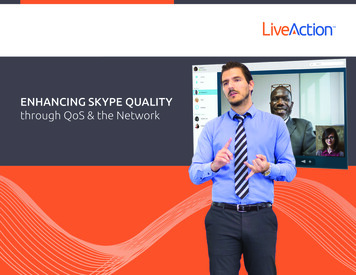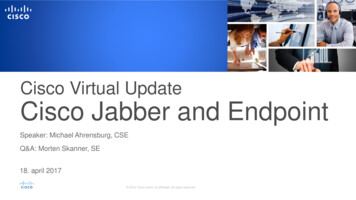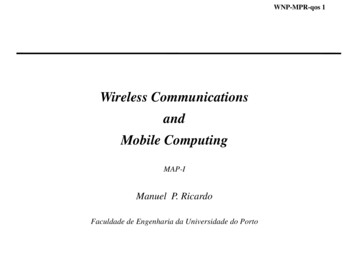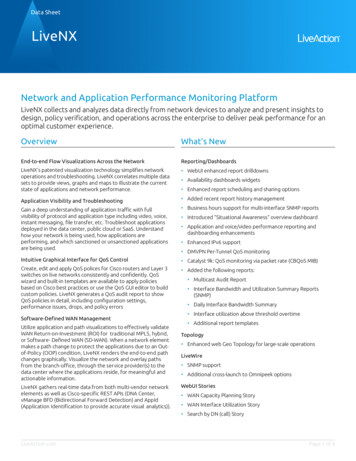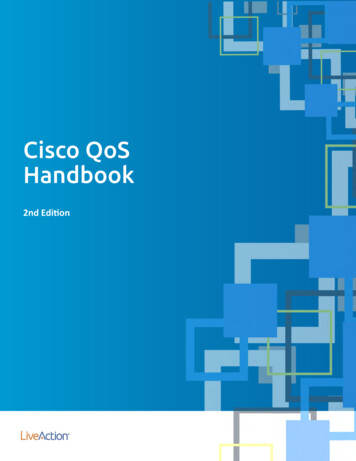
Transcription
Cisco QoSHandbook2nd Edition
Cisco QoS Handbook2nd EditionContentsHow Does QoS Work?. . . . . . . . . . . . . . . . . . .3Traffic Monitoring & Analysis. . . . . . . . . . . . .24Classification & Marking. . . . . . . . . . . . . . . . .5QoS Design & Configuration. . . . . . . . . . . . . .29Queuing . . . . . . . . . . . . . . . . . . . . . . . . . . . . . .7QoS Monitoring & Analysis. . . . . . . . . . . . . . .37Shaping & Policing. . . . . . . . . . . . . . . . . . . . . .8Traffic Generation & Analysis. . . . . . . . . . . . .42Link Efficiency Mechanisms . . . . . . . . . . . . . .9Conclusion . . . . . . . . . . . . . . . . . . . . . . . . . . . .46QoS Deployment Lifecycle . . . . . . . . . . . . . . .10Project Planning & Buy-in. . . . . . . . . . . . . . . .12Appendix A:QoS Configuration Best Practices. . . . . . . . . .47Investigation . . . . . . . . . . . . . . . . . . . . . . . . . .13Design. . . . . . . . . . . . . . . . . . . . . . . . . . . . . . . .14Appendix B:QoS Reference Tables . . . . . . . . . . . . . . . . . . .49Proof of Concept. . . . . . . . . . . . . . . . . . . . . . .17Iterative Deployment . . . . . . . . . . . . . . . . . . .18Appendix C: Validating QoSusing Performance Monitor. . . . . . . . . . . . . .52Ongoing Monitoring & Analysis . . . . . . . . . . .20Appendix D:QoS Glossary . . . . . . . . . . . . . . . . . . . . . . . . . .56Tools for Successful QoS Implementation. . . 21liveaction.com 2020, LiveAction, Inc. All Rights Reserved.2
Cisco QoS Handbook2nd Edition01How Does QoS Work?Quality of Service (QoS) is a suite oftechnologies utilized to managebandwidth usage as data crosses computernetworks. Its most common use is for theprotection of real-time and high priority dataapplications in converged networks. All networkinfrastructure devices have limits on theamount of traffic that can flow through them.In packet and frame switched networks, thisresults in data being delayed or dropped duringtimes of congestion. Quality of Service (QoS)management is the collection of mechanismsthat control how traffic is prioritized andhandled during these times. QoS technologies,or tools, each have specific rolls that are usedin conjunction with one another to build endto-end network QoS policies.The two most common QoS tools used tohandle traffic are classification and queuing.Classification identifies and marks traffic toensure network devices know how to identifyand priorities data as it traverses a network.Queues are buffers in devices that hold datato be processed. Queues provide bandwidthreservation and prioritization of traffic asit enters or leaves a network device. If thequeues are not emptied (due to higher prioritytraffic going first), they overflow and droptraffic.Policing and shaping are also commonly usedQoS technologies that limit the bandwidthutilized by administratively defined traffictypes. Policing enforces bandwidth to aspecified limit. If applications try to use morebandwidth than they are allocated, their trafficwill be remarked or dropped. Shaping definesa software set limit on the transmissionbandwidth rate of a data class. If more trafficneeds to be sent than the shaped limit allows,the excess will be buffered. This buffer canthen utilize queuing to priorities data as itleaves the buffer.3
Cisco QoS Handbook2nd Edition01How Does QoS Work?The WRED (Weighted Random Early Discard)technology, provides a congestion avoidancemechanism that will drop lower priority TCPdata to attempt to protect higher priority datafrom the adverse effects of congestion.Finally, link-specific fragmentation andcompression tools are used on lowerbandwidth WANs to ensure real-timeapplications do not suffer from high jitter anddelay.Diagram: Packet flow through a typical QoS ORITY QUEUECLASS BASED QUEUECLASS BASED QUEUECLASS BASED QUEUEDEFAULT4
Cisco QoS Handbook2nd Edition02Classification & MarkingThe first step in the QoS configuration process is to determine anapplication’s packets and classify them using Layer 2 or Layer 3 QoSmarkings to identify them within the network.CLASSIFICATION METHODSThere are several ways to classify traffic.Some common methods are: Access Control Lists applied to a class-map(IP address, port, etc.) Application Type applied to a class map(via NBAR or NBAR2) Switch port trust stateOnce a packet is identified, it is typicallymarked near the source of the traffic flow,allowing the packets to receive differentiatedtreatment throughout the network. Marking istypically done at the Layer 3 IP header using theDifferentiated Services Code Point (DSCP). LANimplementations use the Class of Service (COS)field. See Appendix B later in this document forbest practices surrounding DSCP marking values.5
Cisco QoS Handbook2nd Edition02Classification & MarkingThere are two paradigms that are generally accepted as best strategiesfor how to best classify and mark traffic. These are:1. THE LANLAN Switches such as Cisco’s Catalyst portfolioperform hardware-based QoS marking at wirespeed. Hence, LAN access switches can be thebest place to enable marking to take advantageof hardware-based QoS and ensure packetsreceive proper treatment throughout thenetwork. Although these hardware-based QoSmechanisms do not significantly impact theCPU load on the switch, they often have limitedconfiguration capabilities like consolidated,basic Access Control Lists for classifying traffic.Another consideration with this strategy isthe sheer number of LAN interfaces thatmust be accurately configured to ensureproper classification and marking are workingeffectively. This often becomes extremelydifficult to manage at scale.2. THE WANWAN routers such as Cisco ISRs and ASRs havemore QoS matching and marking capabilities.This often makes it easier to accurately ensuretraffic is marked as desired. In addition, thereare often significantly fewer interfaces thatneed to be configured correctly to successfullymatch and mark traffic at the WAN edge.Finally, the WAN edge is where QoS congestionis most likely to occur, hence matching andmarking at the WAN edge ensures traffic isproperly identified and subsequently prioritizedaccurately where it is most needed. Those thatchoose this strategy must keep in mind thatby focusing where QoS matters most and issimplest to deploy, the results are practically“good enough” vs. a more complex, technicallyaccurate strategy.6
Cisco QoS Handbook2nd Edition03QueuingThere are several types of queues builtinto network devices. For Cisco devices,the two most common are priority queues(PQs) and Class-Based Weighted Fair Queuing(CBWFQ). Priority queues are designed for usewith packets that require low-latency and lowjitter treatment such as voice or video over IP.PQs will drop any oversubscription during timesof congestion. CBWFQ is designed for bulk andtransactional traffic that are not as time-, loss, or jitter-sensitive. Each CBWFQ queue canspecify a reserved bandwidth that is guaranteedto be available for use by that class during timesof congestion. Finally, queue depth can also beset to ensure traffic bursts can be handled by aqueue.Congestion avoidance mechanisms, such asWeighted Random Early Detection (WRED), canbe used to drop packets as the queues fill up inorder to throttle back TCP-based applications.There are also settings for class-based queuesthat can reduce the possibility of congestion.These settings use DSCP markings to determinethe priority of packets to be dropped before thequeue becomes full.7
Cisco QoS Handbook2nd Edition04Shaping & PolicingPchanges the priority of the packets as theytraverse the network.The policer can also specify thresholds forexceeding as well as violating and can takeactions that include marking down DSCPvalues rather than simply dropping packets.Markdown involves changing the DSCP value inthe IP packet based on flow conditions, whichShaping involves delaying packets that exceeda software defined threshold. If more data istrying to be sent than the shaped threshold,packets are held in the buffer until a later timewhen they can be sent out. This has the effectof smoothing outbursts, but unlike policers,shaping will attempt to not drop packets in theprocess. Queuing polices can be assigned tothe shaped buffer to prioritize applications asthey leave the buffer. If there is congestion ora large amount of traffic; however, the buffermay overflow, causing dropped packets.olicing involves checking the packet ratefor a particular classification of flowsto determine if it conforms to specified ratesettings (e.g., a packet flow for a certain sourcecould be set to not exceed 50 Kbps). The policerwill check to see if there is excess traffic, and ifexcess traffic exists, it can drop the packets inorder to conform to that specified rate.8
Cisco QoS Handbook2nd Edition05Link Efficiency Mechanisms1. LLFI FOR MLP—(Link Fragmentation and Interleaving forMultilink PPP)—MLP splits, recombines, andsequences datagrams across multiple logicaldata links.Large delay-sensitive datagrams are multilinkencapsulated and fragmented into smallerpackets to satisfy delay requirements. Smalldelay-sensitive packets are not encapsulatedbut are interleaved betweenthese fragments.2. LFI FOR FRAME RELAY (FRF.12)—FRF.12 fragments packets that are larger thanthe settings specified using the frame-relayfragment size command.Frame Relay cannot distinguish betweenliveaction.comVoIP and data; therefore configure thefragmentation size on the DLCI so voice framesare not fragmented. The fragment size isspecified in bytes (default 53 bytes). Manyvariables determine the size of the voicepackets.3. CRTP—Compressed real time protocol (CRTP) reducesin line overhead for multimedia RTP trafficresulting in a corresponding reduction in delay.CRTP is especially beneficial when the RTPpayload size is small such as compressed audiopayloads of 20 to 50 bytes.CRTP should be used on any WAN interfacewhere bandwidth is a concern or there is a highportion of RTP traffic. Note that CRTP requiresmore processing on the routers. 2020, LiveAction, Inc. All Rights Reserved.9
Cisco QoS Handbook2nd Edition06QoS Deployment LifecycleDefining and deploying QoS can be a daunting task for any IT department,even with highly skilled engineers on staff.In order to be successful and make the process as manageable as possible, QoS deploymentsshould be broken up into discrete sequential stages that can serve as milestones for the project.A typical implementation would follow these stages:1. PROJECT PLANNING AND BUY-INUnderstand the current and near future QoSneeds of the organization as a whole. Choosean appropriate QoS model and then getdepartmental buy-in before beginning.3. DESIGNSelect a QoS model(s) for the traffic classesand define QoS policies for headquarters andcampus LANs, WANs and branch offices, andVPNs.2. INVESTIGATIONDiscover and document current and futurenetwork architecture. This includes: Gather snapshots existing QoS policies Research the QoS capabilities of thenetwork devices Baseline the network with flow monitoringand usage analysis4. PROOF OF CONCEPT (POC)Test QoS policies and settings first in a nonproduction environment using real andsynthetic traffic to generate controlledconditions. Test separately for each policy andthen with all policies combined.liveaction.com 2020, LiveAction, Inc. All Rights Reserved.10
Cisco QoS Handbook2nd Edition06QoS Deployment Lifecycle5. ITERATIVE DEPLOYMENT CYCLERoll out QoS policies in a phased approach,either by sections of the network or by QoSfunctions (classification then queuing). Confirmchanges at each iteration for at least 24 hoursbefore continuing to the next step.liveaction.com6. ONGOING MONITORING AND ANALYSISPerform ongoing monitoring and adjust thepolicies not just for average daily usage butalso for monthly, quarterly, and yearly businesscycles. 2020, LiveAction, Inc. All Rights Reserved.11
Cisco QoS Handbook2nd Edition07Project Planning & Buy-inThe first step to any successful project is a good plan.This plan involves understanding the QoSneeds of the organization, choosing theQoS model that fits these needs, designing theimplementation, and finally implementing thatdesign.A good plan starts with understanding thebusinesses’ current and near future needs.This will help to define the size and scope ofthe implementation. Perhaps voice services(VoIP) are being implemented now, but videoteleconferencing will be rolled out in a year.liveaction.comKnowing this business objective, a design couldbe chosen that supports both technologiesfrom the start. Another overlooked aspectof planning is getting departmental buy-in.While VoIP deployment may be rolled outcompanywide, there may be some departmentspecific applications that are consideredmission critical and other applications that areplanned for deployment next year. It’s good toget departmental buy-in and understand theirfuture needs before the QoS projectgets started. 2020, LiveAction, Inc. All Rights Reserved.12
Cisco QoS Handbook2nd Edition08InvestigationIf making significant hardware or softwarechanges coincide with any QoS rollouts,make these first before adding complexitywith new QoS policies. This is also a goodtime to snapshot existing QoS policies in caseany changes need to be rolled back later inthe process. The first step in creating a QoSdesign is to gain an understanding of thecurrent network architecture. This includesunderstanding the applications used to supportthe network, and the traffic running over it. IfQoS has not been deployed on the networkbefore, this would be the time to research andunderstand what QoS capabilities are availablein the network devices.liveaction.comIf the network’s traffic patterns have notbeen base-lined, or if there have been recentnetwork changes, now is the time to do so.A NetFlow monitoring application will beneeded to gather and present network trafficinformation for analysis. This informationwill highlight typical utilization patterns ofcurrent network applications and may evenhelp spot problems. This data may evenindicate that further network infrastructurechanges are needed to support any newbandwidth intensive applications such asvideo teleconferencing. Remember, QoS doesnot create bandwidth; it can only optimizethe bandwidth available. This document willhighlight how this can be accomplished usingLiveAction’s LiveNX software. 2020, LiveAction, Inc. All Rights Reserved.13
Cisco QoS Handbook2nd Edition09DesignOnce a solid understanding of current and future QoS requirementsis gathered, it’s time to begin the QoS design.The design may include network changessuch as bandwidth or hardware andsoftware upgrades, but it must include theselection of a QoS model, and the differentrouter and switch policies needed to supportthe model. Policies will need to be tailored tothe different areas of the network. Dependingon the network’s complexity, this may includeaccess, distribution, core, WAN edge, remoteoffices, and security networks and devices.QoS policies may also be implemented atthe Internet edge services for VPN usersif mission-critical or voice applications areaccessed remotely.There are several standardized QoS modelsthat can be chosen to support the number ofclasses required in the network infrastructure.Cisco has defined several models from 3,4, 5, 8, and 11 classes to the latest 12 classliveaction.comMedianet model. More classes are not alwaysbetter for the organization due to hardwarelimitations, MPLS service provider restrictions,or there are not enough IT resources tomanage the extra complexity. Many networksimplement multiple class models for varioussections of their environment. For initialQoS deployment, a smaller 3, 4 or 5 classmodel can be used to simplify the process.The model can easily be expanded over timeas additional applications and requirementsarise.QoS policies should be designed from thehigh-level requirements gathered in theproject planning stage. Once the requirementsare understood, they can be translated toQoS best practices for the various applicationtypes. See Appendix A – QoS Best Practicesfor a reference when designing QoS policies. 2020, LiveAction, Inc. All Rights Reserved.14
Cisco QoS Handbook2nd Edition09DesignDiagram: QoS ShapingORIGINAL BANDWIDTHSHAPED BANDWIDTH40% Realtime30% Critical Data15% Signaling10% Scavenger5%Best EffortLINK SHAPINGIf the network design requires high-prioritytraffic to traverse WAN links, consider how QoSwill be implemented under these circumstances.This may mean upgrading service levels with theprovider to support multiple levels of priority,and then selecting how applications with mapto the providers configurations. If the serviceprovider has no QoS policy on their network,they will disregard any QoS markings on theirnetwork. Traffic can still be prioritized as itleaves the corporate network, but there is noguarantee how it will be treated.liveaction.comFor many WAN environments, there will bea link-speed mismatch between a WAN link’sphysical capabilities and the CommittedInformation Rate (CIR), purchased by theservice provider. This is most common on highbandwidth metro Ethernet WANs and MPLSnetworks where the service providers are notusing QoS. In these designs, use hierarchicalpolicies that shape the QoS policy to the WANlink capacity. 2020, LiveAction, Inc. All Rights Reserved.15
Cisco QoS Handbook2nd Edition09DesignHierarchical WAN traffic shaping involvescreating a high-level (parent) shaping policyand then associating it with a lower-level (child)policy. When applied to an interface, this policyforces the interface to shape all outgoing trafficto the parent class’ rate. Once shaped, thelower level QoS policy queues traffic based onthe shaped value and not the raw interfacespeed itself, thus queuing will result when theshaped value becomes congested.liveaction.comThe committed burst (BC) and excess burst(BE) should be configured to ensure optimumperformance for real-time traffic like VOIP andvideo over IP. The BC should be set to a valueless than or equal to 1/100 of the target shapedrate (CIR). This value may be increased to 2/100for immersive video over IP deployments. TheBE should always be configured as 0. 2020, LiveAction, Inc. All Rights Reserved.16
Cisco QoS Handbook2nd Edition10Proof of ConceptAny significant QoS deployment must startin the test lab. This is where configurationsettings can be tested and validated in a nonproduction environment. Ideally, the test labwill have the same routers and switches andsoftware versions as the production network.liveaction.comReal and synthetic traffic should be generatedin controlled conditions similar to theproduction network to check the operation ofQoS policies and settings. This process must berepeated for each different policy, and finally,together with all other policies deployed. 2020, LiveAction, Inc. All Rights Reserved.17
Cisco QoS Handbook2nd Edition11Iterative DeploymentOnce QoS policies have been validated in a test environment,the process to roll them out in a phased approach can begin.In order to facilitate the daunting task ofimplementing such a large change to a network,it should be broken up into implementationphases. At each phase, a change is made,the change is confirmed through monitoring,adjustments are made, and deployment proceedsto the next phase until the project is complete.This method allows the project to proceed ona flexible schedule that can be interrupted atmilestones while maintaining business continuity.Diagram: Phased Approach with monitoring/tuningMONITOR& TUNEPHASE 1MONITOR& TUNEPHASE 2MONITOR& TUNEPHASE 3liveaction.com 2020, LiveAction, Inc. All Rights Reserved.18
Cisco QoS Handbook2nd Edition11Iterative DeploymentThis phased approach can be carried out indifferent scenarios. One option is to pick asmall portion of a larger network for initialdeployment. This can be a remote site with asmaller network. Another option is to deploythe policies by function. For example, the firstphase would start with just the classificationand marking policies on endpoints andnetwork devices. The traffic can be monitoredto determine if the markings are beingapplied correctly. Once confirmed, queuing,policing, and LFI mechanism can be deployedsystematically.At each stage of policy deployment, the trafficand QoS policies need to be monitored forproper operation. The policies should be finetuned as issues are uncovered. This monitoringshould occur for at least 24 hours but ideally aweek in order to catch different usage patternsthat occur throughout the workday and week.This process of monitoring and fine tuning isrepeated until the deployment is complete.19
Cisco QoS Handbook2nd Edition12Ongoing Monitoring& AnalysisOnce fully implemented, a QoS-enablednetwork will require ongoing monitoringand maintenance. Over time, changes will occurto the usage patterns, new applications will bedeployed, and these changes will need to beincorporated into the existing policies. Anotherconsideration is cyclical usage patterns. Themost obvious of these are the work week cycleliveaction.comwhere traffic occurs in 10-12-hour cycles fromMonday to Friday. However, there are othercycles that occur at the end of fiscal periods suchas monthly, quarterly, and yearly. During thesetimes, voice calls and ERP usage may peak dueto accounting, manufacturing, sales, or internalmeeting activities and these usage patterns willneed to be accounted for. 2020, LiveAction, Inc. All Rights Reserved.20
Cisco QoS Handbook2nd Edition13Tools for SuccessfulQoS ImplementationBefore deploying QoS, consideration shouldbe given to the tools available to staff forperforming the critical functions involved.Implementing QoS requires a wide range offunctions from monitoring and analysis toconfiguration and testing. Budgeting for QoSliveaction.comdeployments needs to include funding fornetwork management software tools. These toolswill ensure accurate and effective QoS policycreation and enable a deeper understanding ofthe network environment for capacity planning,tuning and troubleshooting efforts. 2020, LiveAction, Inc. All Rights Reserved.21
Cisco QoS Handbook2nd Edition13Tools for Successful QoS ImplementationThe following table summarizes specific functions and technical considerationsthat should be evaluated when purchasing network management software for QoS:FUNCTIONUSETOOL CONSIDERATIONS Traffic filtering by IP address, application, DSCP, etc.Traffic monitoringand analysis Initial base-lining and ongoingmonitoring of traffic levels. Long-term recording and reporting Troubleshooting of any problemsencountered Real-time updating for immediate feedback whentroubleshooting End-to-end traffic path visibility for network understanding Support for network flow monitoring technology –NetFlow, Sflow or J-FlowQoS monitoringand analysisQoS policy validation and ongoingmonitoring Support for SNMP MIB monitoring such as Cisco CBQoSand NBAR MIBs Detailed monitoring by class, class drops, application, etc. Historical reporting of QoS performance Wizards and templates for easy policy creationQoS design andconfigurationAssist in defining QoS policies andactual configuration of the networkdevices Rules checking and references to ensure error free changes Intelligent configuration that parses existing router policiesand adjusts changes as needed Load and save policies Push out policies to multiple devicesSynthetic trafficgenerationand analysisTraffic generation and analysis formeasuring the impact of QoS policiesin a controlled mannerConsideration should be given to anapplication such as LiveAction’s LiveNX. LiveNXis an application-aware network performancemanagement tool that will graphically displayhow networks and applications are performingusing SNMP and the latest advanced NetFlowliveaction.com Ability to leverage built-in Cisco IP SLA technology Graphically generate different types of traffic and analyzeperformance in summary and detailed formatscapabilities now embedded in Cisco devices.In addition to showing application andnetwork performance, LiveNX provides theability to control application performance viaits graphical QoS management capabilities.This software solution integrates all of the 2020, LiveAction, Inc. All Rights Reserved.22
Cisco QoS Handbook2nd Edition13Tools for Successful QoS Implementationfunctionality required in a QoS deploymentinto a cohesive, easy-to- manage framework.By combining the entire workflow of analysis,configuration, testing, and tuning into anall-in-one solution, a QoS deployment cangreatly benefit from improved efficiencyand accuracy. Using LiveNX’s built-in expertcapability to build and adjust policiesgraphically, understand network-wide trafficpatterns visually, and gain detailed QoSstatistics enables a quicker understandingof how policies are working and whatadjustments need to be made when tuningQoS policies.LiveNX consoleThe image below is a view of the LiveNX console. It shows a network diagram consisting five network devices and multiple PCs,servers, and IP phones. The five larger green circles represent routers and switches managed by LiveNX. The little circles withinthe devices represents their interfaces. Four of the devices are green indicating good network performance. One device is amber,indicating that this device is having a network/QoS performance issue.liveaction.com 2020, LiveAction, Inc. All Rights Reserved.23
Cisco QoS Handbook2nd Edition14Traffic Monitoring & AnalysisThe early stages of a QoS deployment involves informationgathering that is then used to design QoS policies.For information gathering, NetFlow, NBARand SNMP monitoring and reporting toolsare required. Implementing and analyzing QoSmonitor only policies are also very helpfulin the information gathering stages of a QoSdeployment. The tools used for monitoringthese technologies need to support long termtraffic analysis and reporting at 1-minute orbetter views (no averaging) to gain a thoroughunderstanding of the network’s data usageprior to any QoS policy design.liveaction.comLiveNX can provide both real-time andhistorical views and reports that are specificallytailored for QoS deployments. The followingthree LiveNX screenshots show the real-timeview of a single interface’s performance fromfour different technologies perspectives. Thesespecific views can be used to highlight thevolume of data each application is utilizingon the interface for the last ten minutes. Thisdata can then be used for real-time capacityplanning of QoS policies. 2020, LiveAction, Inc. All Rights Reserved.24
Cisco QoS Handbook2nd Edition14Traffic Monitoring & AnalysisNetFlowThe diagram below shows an interface’s network performance from NetFlow’s perspective.This view is detailing bandwidth by TCP/UDP port usage.NBARThe diagram below shows an interface’s network performance from NBAR’s perspective.The view is detailing bandwidth by application usage. The dotted black line shows interface SNMP’s bandwidth usage.liveaction.com 2020, LiveAction, Inc. All Rights Reserved.25
Cisco QoS Handbook2nd Edition14Traffic Monitoring & AnalysisQoSThe diagram below shows an interface’s network performance from QoS perspective.The view is detailing bandwidth usage by queue. The dotted black line shows the interfaces SNMP’s bandwidth usage.LiveNX can also be used as a Historicalreporting tool. Traffic monitoring andanalysis for QoS policy creation shouldtypically have at least one week’s worth ofhistorical data for accurate policy creation.The following screenshots will highlight asubset of the reports available in LiveNXthat would typically be used as part ofliveaction.complanning a QoS deployment. The reportsshown below should be run on multipledevices and interfaces to understanda network’s overall application usage.Note that all historical reports in LiveNXcan show data at 1-minute granularity.This ensures the reports have the detailrequired for accurate QoS policy creation. 2020, LiveAction, Inc. All Rights Reserved.26
Cisco QoS Handbook2nd Edition14Traffic Monitoring & AnalysisNetFlowThe following diagram shows a historical NetFlow Application report for the same interface as highlighted above.By using the Custom option, the report can be tailored to a desired historical time.27
Cisco QoS Handbook2nd Edition14Traffic Monitoring & AnalysisNBARThe diagram below shows the QoS historical report: NBAR and Post-Policy. This view presents the NBAR and QoS data for thesame interface as highlighted above. This report can be used to gather the volume of bandwidth each application is utilizing on aninterface for the time period selected. By using the Custom option, the report can be tailored to a desired historical time period.If QoS monitoring policies are utilized, as the screenshot below shows, queue bandwidth sizing can more easily be determined forthe QoS design.28
Cisco QoS Handbook2nd Edition15QoS Design & ConfigurationDesigning QoS policies and configuring themon routers is a time-consuming, complex,and intimidating process that requires trainedengineers. This process can be greatly simplifiedby a QoS tool with built-in expert capabilityin the form of GUI wizards, templates, andinteractive screens for designing, deploying,and adjusting QoS policies. LiveNX provideseasy-to-use workflows that enable engineers todeploy, tune, and validate QoS policies across anenterprise network quickly and accurately.LiveNX has built-in advanced QoS policytemplate
liveaction.com2020 ved.10 Cisco QoS Handbook 2nd Edition 1.PROJECT PLANNING AND BUY-IN Understand the current and near future QoS needs of the organization as a whole. Choose an appropriate QoS model and then get departmental buy-in before beginning. 2.INVESTIGATION Discover and document current and future network architecture.

